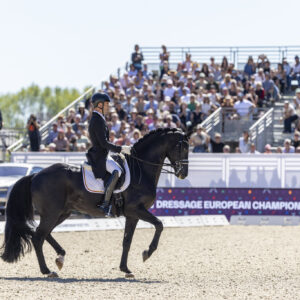Although your local climate and weather conditions will likely have an influence on your horse’s hooves, there are some universal factors that impact hoof quality and growth rate year-round, no matter where you live.
Here we’ll explore the fundamental elements that play a role in your horse’s hoof health.
Activity and Exercise
Farriers and veterinarians will agree that lack of adequate activity and exercise is a challenge to the health and well-being of horses in every way—from the mind to the digestive system, to the joints, to the feet. Mother Nature did not design horses to stand still. That’s right: Your horse’s hoof health is very dependent on healthy circulation to his feet, and healthy hoof circulation is dependent on his movement.
This means limiting stall time by providing as much turnout as possible as well as regular, controlled exercise like riding, driving, hand-walking or whatever you and your horse enjoy together. Even the best diet and the best farrier may not be able to overcome the significant challenge of poor hoof circulation that can result from too much time standing still.
Nutrition
A complete and balanced diet—with a foundation based in quality forage—is also crucial to your horse’s overall health, including his hooves. Quality protein from essential amino acids, balanced macro and trace minerals, fat- and water-soluble vitamins and the right fatty acids are all thought to play a role in the growth rate and quality of your horse’s hoof horn (the thick, keratin-rich tissue that makes up the outer surface of the hoof).
Limiting simple carbohydrates (sugars and starches) may also be important, depending on your horse’s metabolic health. This crucial support from the inside helps contribute to resilient hoof tissues that may better withstand extreme shifts in moisture, such as the seasonal change from spring mud season to summer, added stress like stomping from flies, along with normal wear and tear. Work with an experienced equine nutritionist, together with your veterinarian, to design the optimal diet for your horse’s life stage, workload and specific health considerations.
Keep in mind that good nutrition alone may not overcome the foot health detriments that can result from lack of ample activity and exercise because the good circulation mentioned above is what delivers nutrients to the tissues of the foot.
Also remember that nutritional changes will only affect new hoof growth, and it may take 6-12 months for your horse to fully replace his hoof wall, depending on age, breed, time of year and other factors.
Age and Metabolism
As horses age, the rate and quality of their hoof growth will change. The hooves of young horses generally grow faster than those of senior horses, and thus your youngsters may need to be trimmed more frequently than the older horses in your herd. In some breeds, the feet of older horses tend to flare out and lose sole depth as their connective tissues lose strength due to the normal loss of collagen that comes with aging (just like in humans).
As the connective tissues of the horse’s limbs become more lax with age, the boney column of the limb may begin to descend into the hoof capsule (the structure comprising the hoof wall, sole, frog and heel bulbs), resulting in changes to the shape of the hoof and depth of sole, which your farrier will need to manage accordingly.
Working closely with your veterinarian to understand your horse’s risk for Equine Metabolic Syndrome (EMS) or Pituitary Pars Intermedia Dysfunction (PPID), aka Cushing’s Disease, is also critical to hoof health, as both conditions put horses at a greater risk of developing laminitis. EMS is a condition that can be seen in middle-aged horses, especially “easy-keeper” breeds prone to obesity, and PPID is common in many breeds as the horse enters his senior years.
The importance of proactive management and a great partnership between your veterinarian and farrier can’t be overstated when it comes to metabolic and endocrine disorders and their implications on foot health. The best possible scenario is that you and your horse’s care team stay ahead of these health challenges before the devastating condition of laminitis develops.
Professional Hoof Care and Maintenance
As discussed above, the growth rate and integrity of your horse’s hoof tissues depend on healthy amounts of movement, proper nutrition, age, metabolism and genetics. Some breeds tend to have a certain hoof conformation while other breeds tend to have a stronger or weaker hoof wall, etc.
The job of your farrier or trimmer is to help maintain the hoof capsule so that it is as healthy as possible. This is accomplished through properly balanced trimming at regular intervals: generally, every 4-8 weeks depending on the time of year and your horse’s rate of hoof growth, plus correctly fitting shoes if required for protection and/or traction based on your horse’s individual needs.
As they say, “no hoof, no horse,” so developing a great relationship with both your farrier and your veterinarian is one of the best things you can do for your horse’s hoof health.


 September 11, 2023
September 11, 2023 



























